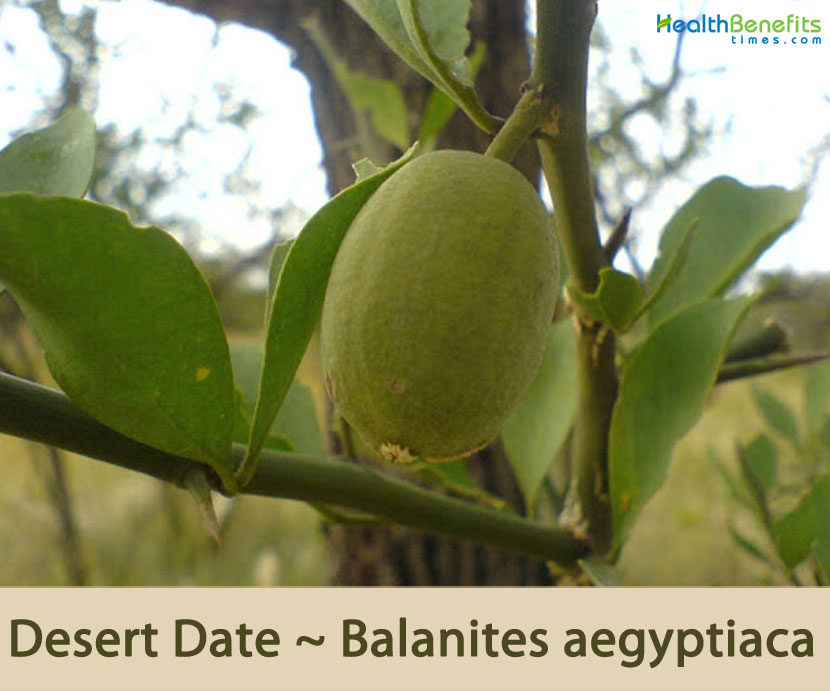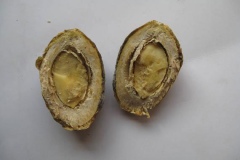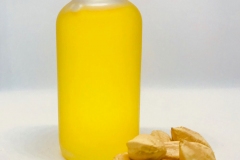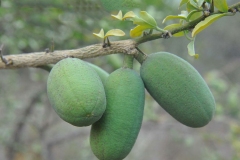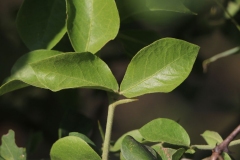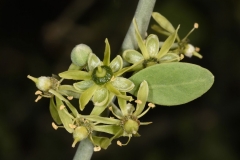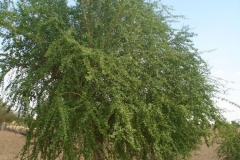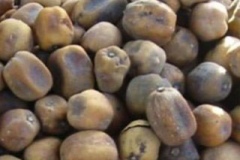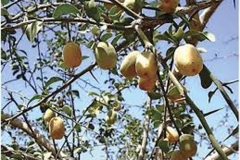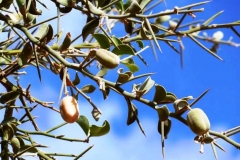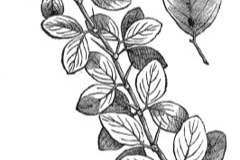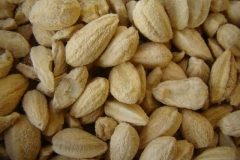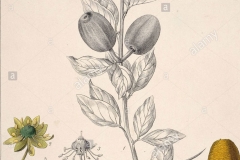There are many common names for this plant. In Arabic it is known as lalob, hidjihi, inteishit, and heglig. In Jieng it is called Thou or thau, in Hausa it is called Aduwa, in Tamasheq, the Tuareg language taboraq, in Fulani or Pulaar “Murtooki”, in Swahili mchunju, in Kamba Kilului and in Amharic bedena. The generic part of the binomial Balanites is derived from the Greek word for an acorn and refers to the fruit, this name was coined by Alire Delile in 1813. The specific name aegyptiaca was applied by Carl Linnaeus as the species was initially described from specimens collected in Egypt.
Desert Date Facts
| Desert Date Quick Facts | |
|---|---|
| Name: | Desert Date |
| Scientific Name: | Balanites aegyptiaca |
| Origin | Much of Africa and parts of the Middle East |
| Colors | Green and tormentose when young, turning brown or pale brown to yellow and glabrous when mature |
| Shapes | Long, narrow drupe, 2.5 to 7 cm long, 1.5 to 4 cm in diameter |
| Health benefits | Treats jaundice, intestinal worm infection, wounds, malaria, syphilis, epilepsy, dysentery, constipation |
| Name | Desert Date |
|---|---|
| Scientific Name | Balanites aegyptiaca |
| Native | Much of Africa and parts of the Middle East. In India, it is particularly found in Rajasthan, Gujarat, Madhya Pradesh, and Deccan |
| Common Names | Desert date, Soapberry tree, Ader, Adogor, Aduwa, Arraronyit, Baddan, Baddanno, Bangbaalu, Bedena, Bito, Bizo, Cheure, Domoko, Dyemo, Ecomai, Egyptian myrobalan, Ekorete, Eroronyit, Ganyamda, Gari, Ghossa, Goot, Hangala, Hangalta, Hankalta, Hawi, Heglig, Heglieg, Hidjihi, Hidjilit, Hingan, Hinganabet, Hingot, Hingota, Hingua, Ingudi, Kasalusalu, Kielege, Kielega, Kiti, Korak, Kudekuda, Kulan, Kullen, Kuri, Lalob, Laloub, Logwat, Logwat, Lubwoti, Lugba, Lungoswa, Maghe, Mduguya, Mfwankomo, Mjirya, Mjunju, Mklete, Mkonga, Mkumudwe, Mng’onga, Mnyra, Model, Modha, Mohoromo, Msalu, Mulului, Muongo, Murtoki, Musongole, Muvambangoma, Mwambangoma, Nanjunda, Njienjia, Nulu, Nyahoko, Nyunguyu, Odhto, Ol-ngoswa, Olg’oswa, Olngoswa, Othoo, Pulupulu, Quud, Regorea, Sadhto, Segene, Seguene, Shifaraoul, Simple thorned torchwood, Sump, Taichot, Tborag, Teboraq, Teboragh, Thoo, Thorn tree, Thou, Tira, Too, Torchwood, Tunywo, Umgobandlovu, UmHulu, Zachun-oil tree, Zegene, Jericho balsam, simple thorned torch tree, simple-thorned torchwood, soap berry tree, Balanite |
| Name in Other Languages | Afrikaans: Enkelgroendoring, enkeldoring-fakkelhout Amharic: Gwasa (ጓሳ) Arabic: Heglig, alzaquwm (الزقوم), hajlij misriun (هجليج مصري), hadjilidge, hejlij, zacon, lalob, hidjihi, inteishit Banbara: Segene, segune, zegene Bengali: Hing Curaçao: Corona de Jesus, korona di Hesus, lamunchi shimaron Czech: Datlovník pouštní English: Desert date, Soapberry-tree, Balanites, Egyptian balsam, Jericho balsam, lalob tree, soap berry tree, soapberry tree, thorn tree, torch wood, Egyptian myrobolan, thorn tree, zachum oil tree, single-thorned torchwood Eritrea: Kog Ethiopia: Bedeno Esperanto: Dezerta daktilo Finnish: Egyptintokopuu French: Dattier du desert, Dattier sauvage, Héglik, myrobalan, Myrobalau d’Egypte, balanite d’Egypte, hagueleg German: Zachunbaum, Wüstendattel, ägyptischer Zachunbaum Ghana: Gungu Hausa: Aduwa Hebrew: Zakkum mitzri, זקום מצרי, זַקּוּם מִצְרִי Hindi: Betu, hingotia, lalo, zachun, hingot (हिंगोट), hingan (हिंगन), hingan-ka-per (हिंगन का पेड़), ingudi (इंगुदी), hingor (हिंगोर) Italy: Dattero deserto, dattero del deserto Kannada: Ingala, ingalarade, ingalare Kenya: Mjunju Malayalam: Otal (ഓടൽ), odamaram, namunta, nanchunta Mali: Taborak Marathi: Hingan, hingalbet, hingam Niger: Garbey, murotanki, taborak Nigeria: Aduwa, cingo, cungo Portuguese: Tamareira-do-deserto, tamareira-do-Egipto Russian: Balanites yegipetskiy (Баланитес египетский) Sanskrit: Ingudee vrksh (इङ्गुदवृक्षः), tapasadruma (तापसद्रुमः), angaravrksa, hinguputra (हिंगुपत्र) Senegal: Segire, serene, sumpo Siddhi: Nanjunda Sudan: Heglig, shashob Swahili: Mjunju, Mujunju Spanish: Mirobalano de Egipto, datilero del desierto, corona di Jesus Tamil: Nanjanada, nanchundan, nancuntan Tanzania: Mkonga, olkwai, olng’oswa, osaragi Telugu: Gara chettu, ringari, gara Uganda: Ecomai, ekorete, mutate Unani: Hingan, Hanguul Urdu: Hingot Wolof: Sump Zimbabwe: Muvambangoma |
| Plant Growth Habit | Deep-rooted, multi branched, spiny, evergreen or semi-deciduous shrub or small tree |
| Growing Climates | Arid and semiarid thickets, sub humid tropical savannas, deciduous bush lands, valley floors, riverbanks or the foot of rocky slopes. It also occurs in hot dry areas, along watercourses and in woodlands |
| Soil | It can be found in many kinds of habitat, tolerating a wide variety of soil types, from sand to heavy clay, and climatic moisture levels, from arid to subhumid. It is relatively tolerant of flooding, livestock activity, and wildfire |
| Plant Size | About 8 meters tall and rarely up to 10 meters (33 ft.) and a trunk diameter of 30 centimeters |
| Truck | Trunk short and often branching from near the base |
| Bark | Reticulate dark brown or grey (rarely green) bark, deeply fissured |
| Leaf | Leathery, light green or dark green leaflets have very different sizes and shapes; they can be asymmetrical and depending on the location with a length of 1 to 6.8 centimeters and a width of 0.3 to 5 centimeters narrow-elliptical, broad-ovoid or obovate with a pointed to blunt base |
| Flowering season | December- March |
| Flower | Fragrant, inconspicuous, hermaphrodite flowers have a diameter of 8 to 14 millimeters and are radially symmetrical and five-fold. The five yellowish or blue-green petals are narrow and obovate-elliptical with a length of 4.5 to 6.5 millimeters |
| Fruit Shape & Size | Long, narrow drupe, 2.5 to 7 cm long, 1.5 to 4 cm in diameter, usually sub cylindric, more rarely narrowly ellipsoid or sub-obclavate, finely puberulous, sometimes glabrescent |
| Fruit Color | Green and tormentose when young, turning brown or pale brown to yellow and glabrous when mature |
| Pulp | Bitter-sweet and edible |
| Seed | Pyrene (stone), 1.5 to 3 cm long, light brown, fibrous, and extremely hard |
| Plant Parts Used | Bark, fruits, seeds, seed oil, and leaves |
| Season | March-July |
Plant Description
Desert Date is a deep-rooted, multi branched, spiny, evergreen or semi-deciduous shrub or small tree with a spherical crown that normally grows about 8 meters tall and rarely up to 10 meters (33 ft.) and a trunk diameter of 30 centimeters. The trunk is short and often branched near the base or the specimen is multi-stemmed. The bark is dark brown to gray and deeply furrowed lengthways. The spread or overhanging branches usually have thorns. The thorns, which are 1 to 4 millimeters above the leaf axils, are strong, yellow or green, usually 2 to 8 (0.4 to 11.5) centimeters long; they are seldom simple and bare, usually they have a few early sloping, scale-shaped, about 0.75 millimeter long leaf rudiments. The bark of the twigs is initially grayish-green and has tiny, fine to tomentose hairs, later turns light brown and bare.
The plant is found growing in arid and semiarid thickets, sub humid tropical savannas, deciduous bush lands, valley floors, riverbanks or the foot of rocky slopes. It also occurs in hot dry areas, along watercourses and in woodlands. It can be found in many kinds of habitat, tolerating a wide variety of soil types, from sand to heavy clay, and climatic moisture levels, from arid to sub humid. It is comparatively tolerant of flooding, livestock activity, and wildfire.
Leaves
Depending on the location, there are often only a few leaves, alternating and spiraling on the branches. The rutty petiole is 2 to rarely 3.5 centimeters long or hardly recognizable with a short rhachis. The pinnate leaf blade consists of only two leaflets. The petioles of the pinnate leaves are usually 1 to 5 (0 to 8) millimeters long. The leathery, light green or dark green leaflets have very different sizes and shapes; they can be asymmetrical and depending on the location with a length of 1 to 6.8 centimeters and a width of 0.3 to 5 centimeters narrow-elliptical, broad-ovoid or obovate with a pointed to blunt base and rounded upper end and smooth edge be. The leaf surfaces are initially hairy to tomentose and then bald.
Flower
Usually 2 to 15 (1 to 20 or more) flowers are more or less close together in clusters on thorny nodes or thorn less short shoots above the leaf axils. The densely downy hairy flower stalks are usually 4 to 11, rarely up to 20 millimeters long. The flower buds are egg-shaped and tomentose.
The relatively small, yellowish-green, fragrant, inconspicuous, hermaphrodite flowers have a diameter of 8 to 14 millimeters and are radially symmetrical and five-fold. The five yellowish or blue-green petals are narrow and obovate-elliptical with a length of 4.5 to 6.5 millimeters. There are ten stamens. The ovary is hairy finely to tomentose. The stylus is 1 to 2 millimeters long.
Fruit
After fertilization, the ovary elongates very clearly into the young fruit. The ellipsoid stone fruit is usually 2.5 to 4 (2.3 to 4.5, rarely up to 7) centimeters in length and usually 1.7 to 2.2 (1.3 to 2.5, rarely) in diameter up to 4) centimeters relatively long and narrow, ovate to ellipsoidal and rounded or truncated at both ends. Young fruits are green and tomentose and usually turn yellow to more or less brown and bare when ripe. When ripe, the fruit skin is brittle. The edible, brown or brown-green pulp is bitter-sweet. The stone core that contains the seed is 1.5 to 3 centimeters long, light brown, fibrous and extremely hard; it makes up to 50 or 60% of the fruit. 500 to 1500 dry, clean seeds weigh about 1 kg.
Flowers are small, inconspicuous, hermaphroditic, and pollinated by insects. Seeds are dispersed by ingestion by birds and animals. The tree begins to flower and fruit at 5 to 7 years of age and maximum seed production is when the trees are 15 to 25 years old.
Traditional uses and benefits of Desert Date
- Desert Date is traditionally used in treatment of various ailments including jaundice, intestinal worm infection, wounds, malaria, syphilis, epilepsy, dysentery, constipation, diarrhea, hemorrhoid, stomach aches, asthma, and fever.
- Decoction of the root is used to treat malaria.
- Roots are boiled in a soup to be used in the treatment of edema and stomach pains.
- They are also used as an emetic.
- The bark is purgative and vermifuge.
- An infusion of the bark is used to treat heartburn.
- Bark is used to deworm cattle in Rajasthan.
- The plant is a potential source of steroidal sapogenins (diosgenin) for the hemisynthesis of corticosteroids.
- The fruits are used in the treatment of liver and spleen diseases.
- Roots are used to treat abdominal pains and as a purgative.
- Gum from the wood is mixed with maize meal porridge to treat chest complaints.
- Seed is used as expectorant, antibacterial, and antifungal.
- Fruit is used in whooping cough, also in leucoderma and other skin diseases.
- Bark is used as spasmolytic.
- Root extracts have proved slightly effective against experimental malaria.
- Root infusion is used as an emetic in Kenya.
- In asthma, about 10 gm. of seed powder is taken with glass of water in the morning for 10 days.
- Fruits are used as an oral hypoglycemic and an anti-diabetic in Egyptian folk medicine.
- An aqueous extract of the fruit mesocarp is used in Sudanese folk medicine in the treatment of jaundice.
- Latex of the plant is used in epilepsy, administered through intranasal route.
- Fruits are used to treat dysentery and constipation.
- Seed oil is used to treat tumors and wounds.
- The bark is used in the treatment of syphilis, round worm infections, and as a fish poison.
- Seeds are used as anthelmintic and purgative.
- Ground seeds are given to camels to cure impaction and colic.
- In East Africa, it is widely used as anthelmintic.
- Root is used in various folk medicines for the treatment of abdominal pain and as purgative, while the bark is used as a fish poison and also as a remedy for malaria and syphilis.
- In Senegal, Nigeria, Morocco, and Ethiopia, B. aegyptiaca is taken a purgative for colic and stomach ache.
- The bark of the plant is helpful in curing epilepsy, yellow fever, jaundice, mental diseases and syphilis and can at the same time act as a fumigant for healing circumcision injuries.
Culinary Uses
- Fleshy pulp of both unripe and ripe fruit is edible and can be eaten dried or fresh.
- Fruit is processed into a drink and sweetmeats in Ghana, alcoholic liquor in Nigeria, a soup ingredient in Sudan.
- Leaves and young shoots are used as vegetables and added to soups.
- They are prepared by boiling and pounding, and are then fried or mixed with fat.
- Flowers are a supplementary food in West Africa and a flavoring in Nigeria.
- They are sucked in order to obtain their nectar.
- Greenish-yellow to orange-red resin is produced from the stems.
- It is sucked and chewed when fresh.
- The kernels produce edible oil used for cooking.
- Kernels are used as supplementary food, to extract oil and as famine food.
- The fruits are also used to brew an alcoholic drink.
- A fruit is sucked by school children as a confectionary in some countries.
Different Uses
Food: The fleshy pulp of both unripe and ripe fruit is edible and eaten dried or fresh. The fruit is processed into a drink and sweetmeats in Ghana, alcoholic liquor in Nigeria, a soup ingredient in Sudan. Young leaves and tender shoots are used as a vegetable, which is boiled, pounded, then fried or fat added to prepare it. The flowers are a supplementary food in West Africa and an ingredient of ‘dawa dawa’ flavoring in Nigeria. Flowers are sucked to obtain nectar.
Fodder: The fresh and dried leaves, fruit and sprouts are all eaten by livestock. As shown in an experiment in Burkina Faso, B. aegyptiaca contributed up to 38% of the dry-matter intake of goats in the dry season. Kernel meal, the residue remaining after oil extraction, is widely used in Senegal, Sudan and Uganda as a stock feed. The tree is lopped for fodder in India.
Fuel: The wood is good firewood; it produces considerable heat and very little smoke, making it mostly suitable for indoor use. It produces high-quality charcoal, and it has been suggested that the nutshell is suitable for industrial activated charcoal. The calorific value is estimated at 4600 kcal/kg.
Fiber: A strong fiber is obtained from the bark.
Timber: The wood is pale yellow or yellowish-brown. Heartwood and sapwood are not clearly differentiated. The wood is hard, durable, worked easily and made into yokes, wooden spoons, pestles, mortars, handles, stools and combs. It shows no serious seasoning defects and no tendency towards surface checking or splitting. The wood saws cleanly and easily, planes without difficulty to a smooth finish and is easy to chisel. It glues firmly and takes a clear varnish. Timber has traditionally been a minor product. The usually small log size and the prevalence of stem fluting make sawmill processing difficult.
Gum or resin: Greenish-yellow to orange-red resin is produced from the stems. It is sucked and chewed when fresh. It is used as glue for sticking feathers onto arrow shafts and spearheads and in the repair of handle cracks and arrows.
Lipids: Kernels produce edible oil used for cooking. The oil remains stable when heated and has a high smoking point, and thus its free fatty acid content is low. Its scent and taste are acceptable.
Alcohol: The fruit may be used to brew an alcoholic drink.
Poison: An emulsion made from the fruit or bark is lethal to the freshwater snails that are the host of miracidia and cercaria stages of bilharzia and to a water flea that acts as a host to the guinea worm. Fish poison can be obtained from the fruit, root and the bark. The active agent of the poison is saponin. Compound is toxic to fish but does not affect mammals and rapidly becomes inert, so that fish retrieved are edible. However, in the Fada region of Cote d’Ivoire, the poison is reported to damage the sight of fishermen after they have used it for 5-6 years.
Medicine: Decoction of root is used to treat malaria. Roots boiled in soup are used against edema and stomach pains. Roots are used as an emetic; bark infusion is used to treat heartburn. Wood gum mixed with maize meal porridge is used to treat chest pains. The bark is used to deworm cattle in Rajasthan.
Other products: The seeds are used for rosary beads, necklaces and in the game of warri played in Sudan.
Other Uses
- The usually evergreen behavior potentially makes this plant an attractive element to introduce into shelterbelts, although because of its slow growth, it is not suitable as a principal species.
- Its thorny habit makes this tree a useful plant for fencing and hedging.
- Oil obtained from the seed has been recommended for the manufacture of soap.
- Strong fiber is obtained from the bark.
- Greenish-yellow to orange-red resin is produced from the stems.
- It is used as glue for sticking feathers onto arrow shafts and spearheads and in the repair of handle cracks and arrows.
- An emulsion made from them is lethal to the freshwater snails that are the host of miracidia and cercaria stages of bilharzia and to a water flea that acts as a host to the guinea worm.
- Pale yellow or yellowish-brown wood is fine-grained, compact, hard, durable and easily worked.
- Wood saws cleanly and easily, planes without difficulty to a smooth finish and is easy to chisel.
- It glues firmly and takes a clear varnish.
- Timber has traditionally been a minor product; it is made into yokes, wooden spoons, pestles, mortars, handles, stools and combs.
- The wood is good firewood; it produces considerable heat and very little smoke, making it particularly suitable for indoor use.
- It produces high-quality charcoal, and it has been suggested that the nutshell is suitable for industrial activated charcoal.
- Trees reach maturity after 25 years, and adult trees may exceed 100 years.
- The fresh and dried leaves, fruits and sprouts are all used as forage for livestock.
- The seeds are used for rosary beads, necklaces and in the game of warri played in Sudan.
- In Chifra District, the root of plant is used for the treatment of render pest and anthrax.
- In Chad, fresh twigs are put on the fire in order to keep insects away.
References:
https://www.itis.gov/servlet/SingleRpt/SingleRpt?search_topic=TSN&search_value=897108#null
https://pfaf.org/user/Plant.aspx?LatinName=Balanites+aegyptiaca
https://plants.usda.gov/core/profile?symbol=BAAE3
https://www.cabi.org/isc/datasheet/8311
https://www.ncbi.nlm.nih.gov/pmc/articles/PMC3210005/
http://tn-grin.nat.tn/gringlobal/taxon/taxonomydetail?id=6322
https://gd.eppo.int/taxon/BALAE
http://www.theplantlist.org/tpl1.1/record/kew-19437
https://www.feedipedia.org/node/181
http://www.medicinalplantsindia.com/desert-date.html
https://indiabiodiversity.org/species/show/264418
https://www.flowersofindia.net/catalog/slides/Desert%20Date.html
http://tropical.theferns.info/viewtropical.php?id=Balanites+aegyptiaca
http://apps.worldagroforestry.org/treedb/AFTPDFS/Balanites_aegyptiaca.PDF


